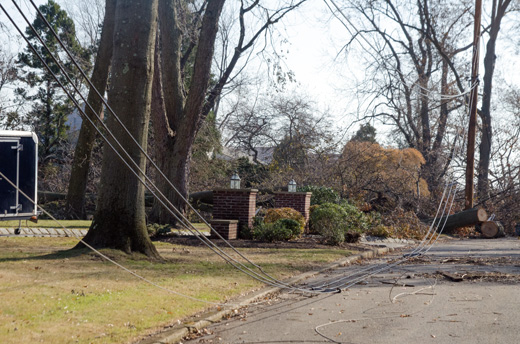Electrical hazards exist in some form in nearly all occupations. However, those hazards multiply for workers involved in cleanup and recovery efforts following major disasters and weather emergencies. One particular life-threatening danger exists around downed and low-hanging electrical wires.
Safety First
Above all else, always consider all equipment, lines and conductors to be energized. Be cautious and if you notice downed wires or damaged electrical equipment, contact appropriate utility personnel. Remember that circuits do not always turn off when a power line falls into a tree or onto the ground. Even if they are not sparking or humming, fallen power lines can kill you if you touch them or even the ground nearby.
Energy
Downed wires can energize other objects, including fences, water pipes, bushes and trees, buildings, telephone/CATV/fiber optic cables and other electric utilities. Even manhole castings and reinforcement bars (re/bar) in pavement can become energized by downed wires. During storms, wind-blown objects such as canopies, aluminum roofs, siding, sheds, etc., can also be energized by downed wires.
Backfeed
When electrical conductors are inadvertently energized by other energy sources, backfeed occurs. Some of those sources include:
• Circuit ties/switch points
• Lightning
• Generators
• Downstream events
Simply testing for energy sources is not sufficient since hazardous electrical events can happen without warning. Ensure that proper lockout/tagout procedures are always followed.
Rules to live by
• Do NOT assume that a downed conductor is safe simply because it is on the ground or it is not sparking.
• Do NOT assume that all coated, weatherproof or insulated wire is just telephone, television or fiber-optic cable.
• Low-hanging wires still have voltage potential even if they are not touching the ground. So, “don’t touch them.” Everything is energized until tested to be de-energized.
• Never go near a downed or fallen electric power line. Always assume that it is energized. Touching it could be fatal.
• Electricity can spread outward through the ground in a circular shape from the point of contact. As you move away from the center, large differences in voltages can be created.
• Never drive over downed power lines. Assume that they are energized. And, even if they are not, downed lines can become entangled in your equipment or vehicle.
• If contact is made with an energized power line while you are in a vehicle, remain calm and do not get out unless the vehicle is on fire. If possible, call for help.
• If you must exit any equipment because of fire or other safety reasons, try to jump completely clear, making sure that you do not touch the equipment and the ground at the same time. Land with both feet together and shuffle away in small steps to minimize the path of electric current and avoid electrical shock. Be careful to maintain your balance.
This is one in a series of informational fact sheets highlighting OSHA programs, policies or standards. It does not impose any new compliance requirements. For a comprehensive list of compliance requirements of OSHA standards or regulations, refer to Title 29 of the Code of Federal Regulations. This information will be made available to sensory impaired individuals upon request. The voice phone is (202) 693-1999; teletypewriter (TTY) number: (877) 889-5627.

